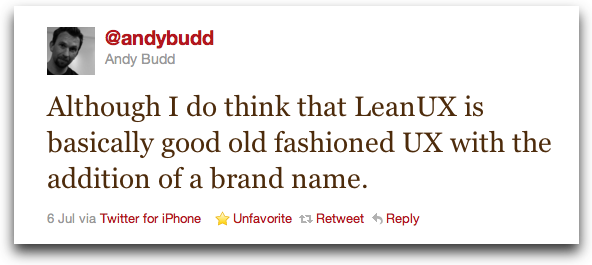Is Lean UX Just A Brand Name?
Andy Budd suggested that Lean UX is just UX with a brand name.
As I suggested in my post on special collections, I think there is something to Lean UX. It was created as a response to Lean Startups, a movement that I think has merit too.
Lean UX is about reducing deliverables and moving towards thinking about the design. While there are no new skills to add to our UX skill list, there’s a line of thinking that is special to Lean UX that you don’t see when people aren’t practicing it.
Primarily, it’s about getting the UX practice as close to the development cycle as you can. It tends to focus on building working prototypes and getting feedback quickly.
Of course, regular UX has always wanted to have fast iterations, but the waterfall approach of specifying design requirements and working out complete designs before coding starts has been pervasive in many organizations.
The deal is that startups can’t afford a lot of “thinking” time associated with a waterfall-esque design process. They have a limited runway (the time it takes to launch a product) and they need designs fast.
Before Lean UX, the startup method of design was to just take whatever emerged from the architecture of the system. Developers were frequently creating the screens themselves, often without any consideration for what we’d call “design.” Their goal was to get something – anything – up and running as soon as possible.
Lean UX says, “we can help get something better.” It brings a deliberate design ethic to the startup process. However, it has to live within the limited runway environment, therefore it can’t be expensive and time consuming. Designs have to come quickly.
Someone who has spent time designing in this world will develop experience and knowledge that’ll provide value. UX professionals that haven’t had a chance to gain this specific flavor of experience will struggle in the startup world.
Interestingly, I think we’ll see a lot of what happens in lean UX environments feeding back into our thinking in non-lean environments. Hopefully, we’ll start to question the footprint of our processes and ask which deliverables are really necessary. Maybe the real contribution of lean UX is making us all aware of how un-lean much of our work really is.
